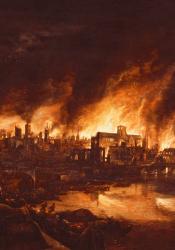The Great Fire of London
The Great Fire of London (1666) [Chapter 3, pp. 119, 127] is described as one of the worst fires in London's history. It started in the King's baker's house by the London Bridge by accident on Sunday, September 2 and spread with wind into the City of London, destroying a large portion including civic buildings, old St. Paul’s Cathedral, 87 parish churches, and about 13,000 houses (Jokinen). Houses at the time were extremely flammable due to the fact that they were made of wood and pitch construction, causing a large expansion of the fire across three days. The fire was not reported to have taken many lives, but it did displace thousands of citizens and left a majority of the city in ruins. King Charles II's plan to rebuild the city involved creating wider streets and buildings of brick.
In Woolf's Orlando, the narrator first mentions The Great Fire when discussing the English Civil War (1642-1641) and the "fire" that "followed" and "damaged or destroyed all those papers from which any trustworthy record could be drawn" (Woolf 119). The narrator then later uses a manuscript from the diary of a man named John Fenner Brigge and mentions that the manuscript was "full of burns and holes, some sentences being quite illegible" (127), of which we assume to be associated with this previously-mentioned event. Woolf's reference to this event in the novel not only highlights an important disaster that marks significant change for London, but it also highlights the way historical accounts can be destroyed or fragmented in disasters and still be used to report the "truth" by historians and biographers. (271 word count)
Jokinen, Anniina. “The Great Fire of London, 1666.” Luminarium, 23 Mar 2012, http://www.luminarium.org/encyclopedia/greatfire.htm.
Woolf, Virginia. Orlando: A Biography. Mariner Books, 1973.

